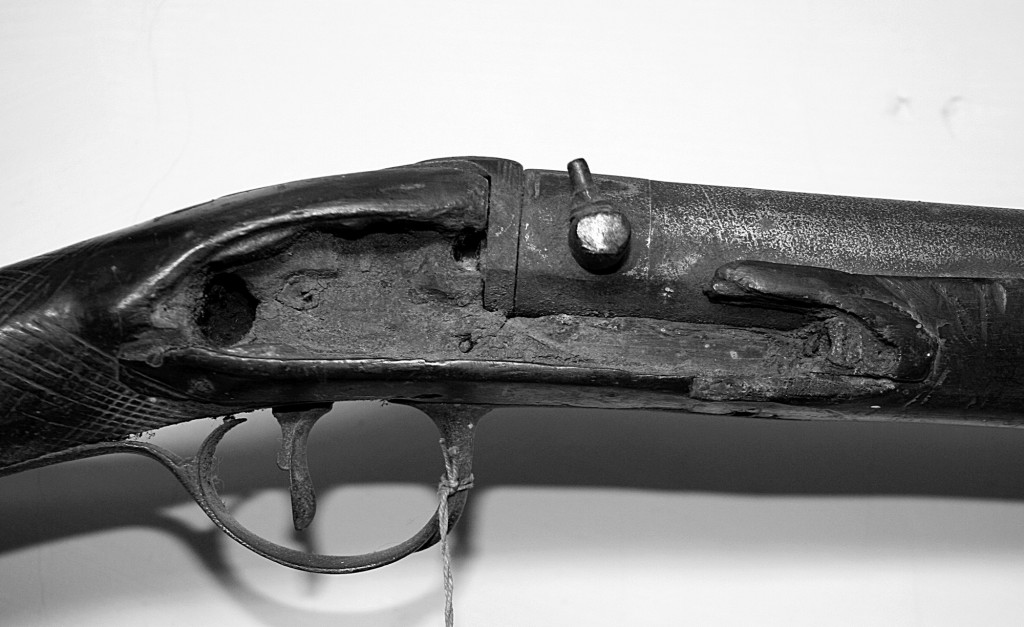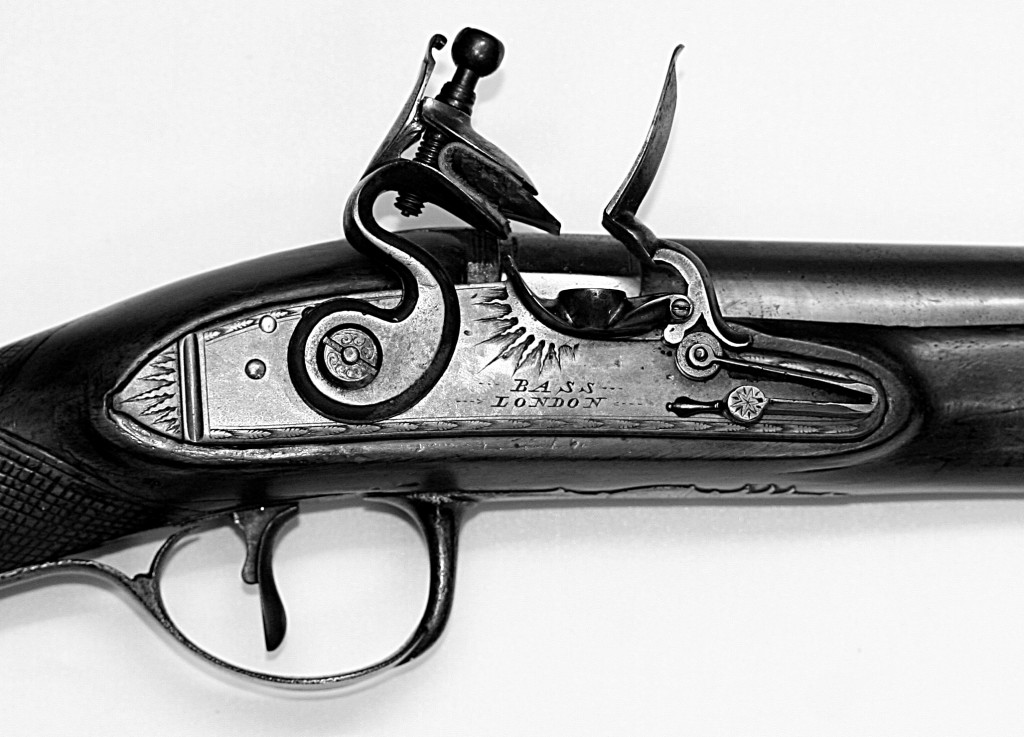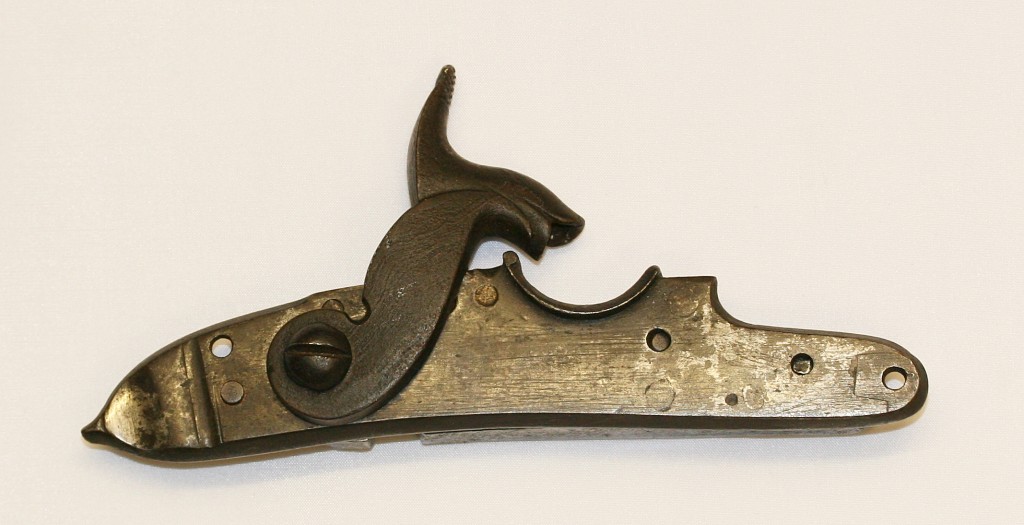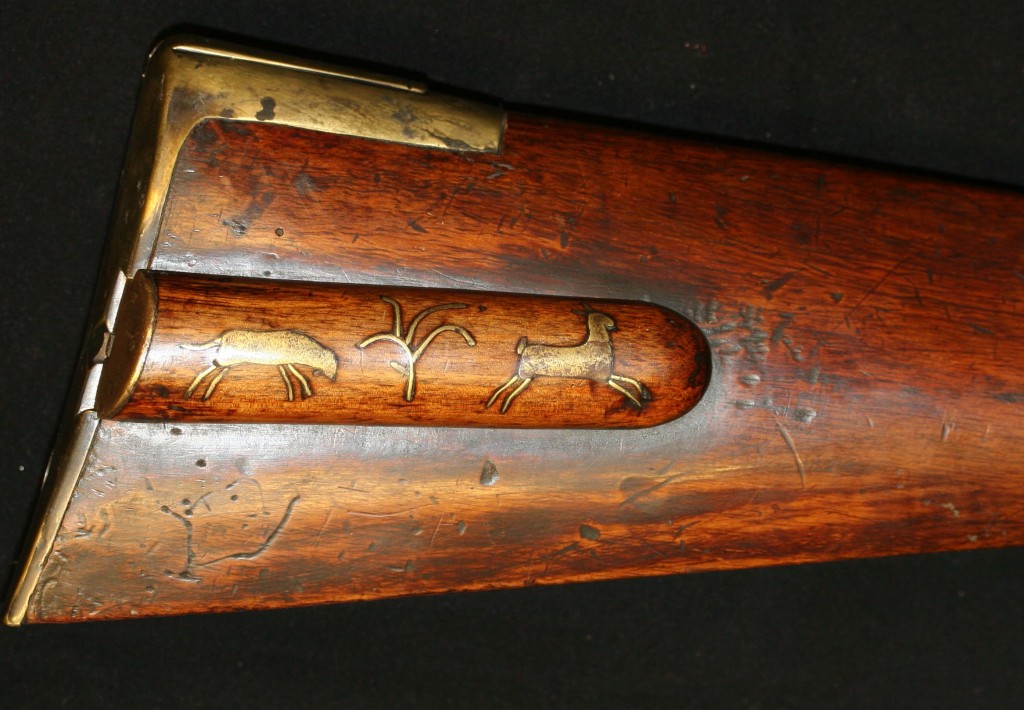A Beginners’ Guide to
Collecting and Restoration
Part 1: Introduction.
By Tim Owen
First Published in the Summer 2014 edition of Black Powder, the magazine of the Muzzle Loading Association of Great Britiain.Read here or download a pdf BG – A Beginners’ Guide -Collecting and Restoration
I have to confess that the beginners in the title include me, so if you consider yourself an expert, now is a good time to skip to the next article! One of the attractions of collecting and restoring antique guns is that there is always something else that you really wish you knew, so I suspect that in one way or another we are all beginners. I only became seriously interested about 7 years ago when I inherited my father’s collection of old guns and had to decide what to do with them. As they included the Westerly Richards 13 bore percussion gun that I had used as a boy to shoot pigeons – in those days powder and shot and caps were a lot cheaper than 12 bore cartridges – the decision wasn’t difficult. As an engineer by profession I got drawn into fiddling with them, and was introduced to a like-minded but much more competent gunsmith who lived ten miles away, after which I became hooked, and the existence of the Lakenheath Muzzleloaders an equal distance in the opposite direction had me wanting to shoot them again. From there it was a short step to an interest in gun engraving, which is now perhaps my main interest.
Among the many books that came with the collection was a small book by Ronald Lister called Antique Firearms – Their Care, Repair and Restoration and published in 1963 that fascinated me because it was so perfectly of its time. Although of course the antique guns haven’t changed, a similar book written now would be very different, and certainly wouldn’t contain a chapter on how to lay out your workshop, with full instructions for making the bench! As I certainly don’t know enough to fill a book, I thought I would see if I could persuade the Editor of Black Powder to include a few articles in Lister’s footsteps!
Anyone who collects or shoots antique guns will be aware that guns made several hundred years ago are quite likely to have had work done on them over their original working life and also during their subsequent life as collectable or shootable antiques. A quick scan through auction catalogues will usually reveal a number of guns with repairs or replacements or conversions done during their original working life, often noting whether the work appears to have been done by the original gunmaker. Work done while the gun was still considered valuable will usually have been carried out to a compatible standard ,even if not by the maker, but once it is no longer a valued possession it is likely to have been passed on to a new owner and repaired, or if a flintlock, converted, with an eye to minimising the cost.
Some of the most popular muzzle loading guns that are collected and regularly used are late 18th century or early 19th century flintlock long guns or the various sorts of percussion gun from about 1820 onwards. Many flintlocks of this period were converted to percussion once the copper percussion cap became dominant. Some of these conversions were undertaken by the original maker, and when done by a gunmaker who was active in developing patents and improvements the conversions are likely to incorporate the latest patent ideas.
One such feature that was often incorporated in the better class of conversion was the patent breech. A problem with early flintlocks had been slow spread of ignition through the main charge, and although the adoption of the chambered breech improved combustion and allowed shorter barrels to be used , it didn’t speed up ignition significantly. Henry Nock improved matters with his patent breech of 1780s, introducing a secondary powder chamber closely coupled to the touch hole that allowed the primer charge to fire the whole of a smaller charge which in turn set off the whole of the main charge more quickly than by direct firing, somewhat counter-intuitively perhaps. The development of the percussion cap brought some improvements in reliability and some increase in speed. Makers like Henry Nock, Durs Egg and Westley Richards had their own designs of breech in an attempt to improve ignition. This, and a desire to mount the nipple close to the barrel meant that a high quality conversion always involved getting rid of the previous breech arrangement and fitting a new, patent, breech block.
Flintlocks that had either been of indifferent quality originally or better ones that had been discarded by their original owner were converted in the cheapest way possible, by cutting away the pan and frizzen bearing and tapping a large hole in the barrel in the position of the touch hole, into which a drum with a nipple was screwed or brazed, and replacing the flintcock with a percussion cock.
Alongside the basic conversion of flint to percussion, conversions were often accompanied by other incidental changes to bring the guns into line with the current practice, depending upon the age of the flintlock. Barrels were sometimes shortened, full stocked guns converted to half stocked ,and the stock chequering recut with diamond rather than the older flat topped chequering, or none at all. The new cocks often had engraving that didn’t fit with the rest of the furniture, and sometimes the nose of the lockplate that had been hidden by the frizzen spring was engraved, which would have involved annealing the lockplate and re-hardening it afterwards. Conversions can be confirmed by the plugged holes for the frizzen spring unless a new complete lock was fitted.
So far we have considered work that was undertaken to extend the original working life of the gun, which would have been undertaken using exactly the same tools and materials as had been used in the original manufacture. There was no arc or gas welding, and the available adhesives had very limited strength and so were not really suitable for major repair of woodwork – instead plates, pins and screws had to be used. These limitations mean that most old repairs are either obvious or are done by replacement of parts made in the same way as the originals, which effectively become part of the guns history.
Spotting modern repairs, reconstructions and re-conversions can be much more difficult, partly because the purpose of such work is usually to recreate something that looks and functions exactly like the original, and sometimes with the direct intention to deceive, whereas work done in the past was intended to extend the working life of the gun. Sellers of antique guns are understandably less likely to point out new work than honest original work, although replacement cocks are occasionally mentioned, and re-browned barrels are usually highlighted, as if replacing the patina of age with an unauthentic ginger gleam made the antique more desirable, or possibly to warn off discriminating collectors.
The ethics of modern gun restoration is complex, and everyone has a slightly different view of what is justifiable work and what is barefaced fakery. The Society for the Protection of Ancient Buildings has a well-developed code relating to old building and gun restorers could do worse than espouse some of its principles. These, in summary, say that any new work should be identifiable for what it is, and should not destroy original material, including evidence of previous alterations and conversions. The reasoning behind these principles is that we are merely the temporary guardians of our historical heritage, and that future generations should be able to appreciate and research it uncontaminated by deliberate misrepresentation.
What in practice does this mean for a gun restorer or someone in possession of a gun they would like restored? There are, for instance, a number of old guns around which have very little intrinsic value and are in very poor condition that would almost certainly end up stripped down for parts or consigned to the bin if they were not restored. In this case it is clearly acceptable to undertake restoration, including the reconstruction of missing parts, provided that it is not subsequently passed off as something that it is not.
Fig 1. A junk gun without lock and with much rust and damage to stock – very little historical value here
The gun shown in fig 1 is an example – without a lock it’s fate is uncertain, as reconstructed it is an attractive piece, and since it is honestly marked, doesn’t confuse the record. On the other hand, a good gun made as a flintlock by Egg or a Nock or a Manton, and subsequently converted to percussion by a maker of equal quality with a re-breeched barrel is an antique in its own right and deserves to be kept as it was converted, rather than turned back into a flintlock with components of possibly dubious authenticity.
Fig. 2. Gun of Fig 1 restored as a flintlock by constructing a new lock – identified internally as modern work. The pan section is a casting welded into a new plate, and the simple engraving is based on a very similar lock.
If you have a flintlock that has been converted to percussion by the drum and nipple method with a screwed in drum, and you want to convert it back to flintlock, then make a new lockplate and touchhole plug and get a pan, cock and frizzen casting and keep all the original parts intact with the gun, so nothing has been lost. It’s a moot point whether you should then engrave the lockplate to match the original, or make your own design with your own name, but in any event stamp the back of the lock plate to identify your work and the year, or better still engrave your name under the cock as I did when engraving the lockplate shown below for a very wrecked Lancaster rifle that had lost its original locks.
New lockplate for restoring a derelict Lancaster – note restorer’s name and date around tumbler spindle hole.
Having justified the construction of new parts, one faces the dilemma of whether it is acceptable to try to recreate the wear and tear and surface corrosion of an original, or to leave the new parts looking new. Opinions will differ, but my own view is that the new parts need to blend in and not ‘shout down’ the original parts. In practice this means that they need to have a compatible surface finish, bluing or browning, and possibly to have sharp edges removed.
Collectors and shooters wishing to avoid buying something that is not what it purports to be, or is ‘over restored’, need to be aware of what modern techniques are available, and also to keep in mind that it was not uncommon for lesser gunmakers to put the names or near imitiations of the names, of the famous on their guns. The way to avoid being caught out is simply stated, but harder to do! The two main rules are 1) Know as much as you can about the period and the guns you are interested in and 2) Remember, if it looks too good to be true it probably is! Knowing about the types of guns that interest us is what we all strive for, but when looking at a possible purchase there are some basic rules;-
Stand back and look at the gun – what is it, what was it used for? Does it fit a pattern of similar guns? Do the various parts belong to the same period? Is the style of the stock right? Do you recognise the maker’s name as being found on similar guns – basically does it seem right? There is no substitute for time spent looking at guns and illustrations in books and trying to tie down the chronology of passing fashions and changing techniques . Collectors usually keep library of books on their interest areas, but it is worth collecting pictures and descriptions of such guns from auction catalogues and websites. It is often made difficult to save detailed photos from some websites, but they can often be saved to your computer by bypassing the website software as follows;- Get the picture you want to save, zooming in and panning to give the best picture – get a full screen image if it will let you – there is usually a button somewhere. Having got your picture on the screen, you will probably find that you can save the image to your clipboard using the PrintScreen key (Print Scrn ). If the website software stops you, move the cursor to the part of the screen where the computer options pop up – top, bottom or side according to how your computer is set up. While the computer options are on the screen, the website software does not have control of the computer, and PrintScrn should work. To see and save the software that is on your clipboard you need to paste it – now open any software that lets you insert pictures – Microsoft Paint is on most computers and works, or you can do it in Word or similar – put the cursor over a blank page or drawing sheet, click the right mouse button and select paste – your picture should appear – now save it in the normal way.
Look carefully at the wear on the various parts of the gun – expect to see levels of wear consistent with the handling that each part gets, and the corrosion that it might experience in normal use – the bow of the trigger guard and the tang of the butt cap usually have the most wear, but anything that is not in balance needs explaining. One aspect of antique guns that is not valued as much as with other antiques is the patina – that undefined ‘lived in’ feel. Anything that looks too new is suspect and may reduce the value. Look particularly carefully at the fit between the furniture and the wood, where parts have been replaced the fit may not be perfect, and casting made to match a pair will show a gap due to shrinkage in the casting process.
On double guns compare the two sides, locks, pins etc as parts may have been replaced with non matching replacements.
Does the engraving look right? There were changing patterns of engraving that were common across many makers, since many gunmakers used the same engravers. There were also set styles for the different parts of the gun and its furniture. Learn to look carefully at these through a loupe and it will give you additional clues.
Having looked hard and in detail at the gun, if it seems that it all belongs, ask yourself it it’s too good to be true. If you think it is, walk away and leave it for someone else!
The Jeager percussion conversion was found with missing side plate, trigger guard and buttcap and in poor condition. Furniture replaced and alternative lock made – the percussion lock was retained intact. The continental lock has a screwed in pan section, which makde things easier. The lock pocket still needs atttention – it was cut away originally when the tumbler wore and the sear fouled on the wood.
The buttcap was modelled in casting wax, slightly oversize, and then cast and filed to fit.
The other side of the stock has the date 1821 inlaid in similar primitive style.
The techniques available to restorers and fakers are highly sophisticated, and I have seen some guns lately that had parts perfect colour case hardening in pristine condition as if newly made by the original maker – if, that is, one deemed it likely that somehow they had spent the best part of 2oo years in pristine condition in storage while inconspicuous parts of the gun received a normal level of wear. Indeed I almost did believe it, until I saw the third set of such locks by different makers in as many months! There are some (presumably) genuine antique high quality guns that have been so over-restored as to be more perfect than they were originally, and I recently saw a pair of such pistols that had been sent to a restorer to be returned to a less contrived appearance.
The tools now available to restorers are pretty sophisticated, but those just becoming available offer even more scope. Restoration largely depends, like the original manufacture, on hand work and the skill of the restorer, but we have some tools available that enable us to do things that were not possible when our guns were made. Argon arc welding offers the possibility to repair iron and steel parts, including joining very fine parts and building up lost material with minimal damage to surrounding metal, including welding steels with high carbon content. Recent developments in laser welding take things to an even higher level of precision, and allow almost invisible joining and precise building up – Laser welding is becoming more widely available, and is already used in the gun trade, especially for barrel repairs.
The basic technique for making missing metal parts is lost wax casing in steel, brass or silver. A wide range of existing castings are available from for example E.J.Blakley and Sons or Peter Dyson and Son, or custom silicone moulds can be made to replicate your own parts. I have used castings from Blackley that are of very high quality, so that the engraving on lock plates etc. is clear, and with a little light re-cutting is almost indistinguishable from the original. The problem inherent in the use of castings is, however, the shrinkage that occurs, both in the casting of the wax as it cools within the silicone mould, and of the steel as it cools in the ceramic moulds. These two lots of shrinkage reduce the size of the finished part by around 3 to 5%, which is enough to be noticeable if you are using casts to replace missing parts of a pair for instance. It is now possible to use 3D printers to print waxes that can subsequently be cast, and as the printing is done from digital representations of the parts, it is a simple matter to scale up the part digitally by the required amount. At the moment the 3D wax printing services do not offer as high resolution or as good a surface finish as the silicone moulds at a reasonable price, but that is likely to change. There is currently no easy way of getting the shape of a complex gun part into a digital form – the required resolution is higher than readily available scanners, and direct design on a computer is possible for simple shapes but difficult for parts like cocks and frizzens. Scanners of the required resolution are in use – dental laboratories that used to make extensive use of lost wax casting for bridges and other dental parts are now moving to precision scanners and CNC milling to make small parts or patterns and other industries have similar capability. It is also possible to ‘print’ parts using laser sintered metal in a form of 3D printer, although the resolution isn’t as good as lost wax yet. lt is, nevertheless, only a matter of time, and not much of it, before these techniques become routine across sufficient industries for the availability and price to be competitive with existing techniques.. We live, as the Chinese curse goes, in interesting times!





